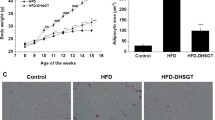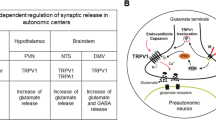Abstract
The capsaicin receptor, known as transient receptor potential vanilloid subfamily member 1 (TRPV1), is an important membrane receptor that has been implicated in obesity, diabetes, metabolic syndrome and cardiovascular diseases. The rabbit model is considered excellent for studying cardiovascular and metabolic diseases, however, the tissue expression of TRPV1 and physiological functions of its ligand capsaicin on diet-induced obesity have not been fully defined in this model. In the current study, we investigated the tissue expression of TRPV1 in normal rabbits using real-time RT-PCR and Western blot analysis. Rabbit TRPV1 mRNA was highly expressed in a variety of organs, including the kidneys, adrenal gland, spleen and brain. A phylogenetic analysis showed that the amino acid sequence of rabbit TRPV1 was closer to human TRPV1 than rodent TRPV1. To examine the effect of capsaicin (a pungent compound in hot pepper) on body weight, rabbits were fed with either a high fat diet (as control) or high fat diet containing 1% hot pepper. We found that the body weight of the hot pepper-fed rabbits was significantly lower than the control group. We conclude that the intake of capsaicin can prevent diet-induced obesity and rabbit model is useful for the study of TRPV1 function in cardiovascular and metabolic diseases.




Similar content being viewed by others
References
Szallasi A, Cortright DN, Blum CA, Eid SR (2007) The vanilloid receptor TRPV1: 10 years from channel cloning to antagonist proof-of-concept. Nat Rev Drug Discov 6(5):357–372
Tominaga M, Tominaga T (2005) Structure and function of TRPV1. Pflugers Arch 451(1):143–150
Szolcsanyi J (2004) Forty years in capsaicin research for sensory pharmacology and physiology. Neuropeptides 38(6):377–384
Suri A, Szallasi A (2008) The emerging role of TRPV1 in diabetes and obesity. Trends Pharmacol Sci 29(1):29–36
Ching LC, Kou YR, Shyue SK, Su KH, Wei J, Cheng LC, Yu YB, Pan CC, Lee TS (2011) Molecular mechanisms of activation of endothelial nitric oxide synthase mediated by transient receptor potential vanilloid type 1. Cardiovasc Res 91(3):492–501
Harper AG, Brownlow SL, Sage SO (2009) A role for TRPV1 in agonist-evoked activation of human platelets. J Thromb Haemost 7(2):330–338
Yang XR, Lin MJ, McIntosh LS, Sham JS (2006) Functional expression of transient receptor potential melastatin- and vanilloid-related channels in pulmonary arterial and aortic smooth muscle. Am J Physiol Lung Cell Mol Physiol 290(6):L1267–L1276
Kawada T, Hagihara KI, Iwai K (1986) Formation and metabolism of pungent principle of capsicum fruits—effects of capsaicin on lipid-metabolism in rats fed a high-fat diet. J Nutr 116(7):1272–1278
Yanni AE (2004) The laboratory rabbit: an animal model of atherosclerosis research. Lab Anim 38(3):246–256
Russell JC, Proctor SD (2006) Small animal models of cardiovascular disease: tools for the study of the roles of metabolic syndrome, dyslipidemia, and atherosclerosis. Cardiovasc Pathol 15(6):318–330
Fan J, Watanabe T (2003) Transgenic rabbits as therapeutic protein bioreactors and human disease models. Pharmacol Ther 99(3):261–282
Zhang C, Zheng H, Yu Q, Yang P, Li Y, Cheng F, Fan J, Liu E (2010) A practical method for quantifying atherosclerotic lesions in rabbits. J Comp Pathol 142(2–3):122–128
Kwon MJ, Song YS, Choi MS, Song YO (2003) Red pepper attenuates cholesteryl ester transfer protein activity and atherosclerosis in cholesterol-fed rabbits. Clin Chim Acta 332(1–2):37–44
Cheng S, He S, Chen W, Wu Y (2009) Detection of capsaicin and dihydrocapsaicin content and analysis of pungency degree in different pepper genotypes. Nat Sci J Hainan Univ 27(1):38–42
Zheng H, Zhang C, Yang W, Wang Y, Lin Y, Yang P, Yu Q, Fan J, Liu E (2009) Fat and cholesterol diet induced lipid metabolic disorders and insulin resistance in rabbit. Exp Clin Endocrinol Diabetes 117(8):400–405
Liu E, Kitajima S, Higaki Y, Morimoto M, Sun H, Watanabe T, Yamada N, Fan J (2005) High lipoprotein lipase activity increases insulin sensitivity in transgenic rabbits. Metabolism 54(1):132–138
Zhang Y, Xiang B, Li YM, Wang Y, Wang X, Wang YN, Wu LL, Yu GY (2006) Expression and characteristics of vanilloid receptor 1 in the rabbit submandibular gland. Biochem Biophys Res Commun 345(1):467–473
Liang J, Liu E, Yu Y, Kitajima S, Koike T, Jin Y, Morimoto M, Hatakeyama K, Asada Y, Watanabe T, Sasaguri Y, Watanabe S, Fan J (2006) Macrophage metalloelastase accelerates the progression of atherosclerosis in transgenic rabbits. Circulation 113(16):1993–2001
Yu Q, Lin Y, Yang P, Wang Y, Zhao S, Fan J, Liu E (2011) C-reactive protein is associated with the progression of acute embolic stroke in rabbit model. J Thromb Thrombolysis [Epub ahead of print]
Thompson JD, Higgins DG, Gibson TJ (1994) CLUSTAL W: improving the sensitivity of progressive multiple sequence alignment through sequence weighting, position-specific gap penalties and weight matrix choice. Nucleic Acids Res 22(22):4673–4680
Saitou N, Nei M (1987) The neighbor-joining method: a new method for reconstructing phylogenetic trees. Mol Biol Evol 4(4):406–425
Felsenstein J (1985) Confidence-limits on phylogenies—an approach using the bootstrap. Evolution 39(4):783–791
Starowicz K, Cristino L, Di Marzo V (2008) TRPV1 receptors in the central nervous system: potential for previously unforeseen therapeutic applications. Curr Pharm Des 14(1):42–54
Leung FW (2008) Capsaicin-sensitive intestinal mucosal afferent mechanism and body fat distribution. Life Sci 83(1–2):1–5
Yang D, Luo Z, Ma S, Wong WT, Ma L, Zhong J, He H, Zhao Z, Cao T, Yan Z, Liu D, Arendshorst WJ, Huang Y, Tepel M, Zhu Z (2010) Activation of TRPV1 by dietary capsaicin improves endothelium-dependent vasorelaxation and prevents hypertension. Cell Metab 12(2):130–141
Eilers H, Lee SY, Hau CW, Logvinova A, Schumacher MA (2007) The rat vanilloid receptor splice variant VR.5’sv blocks TRPV1 activation. Neuroreport 18(10):969–973
Hellwig N, Albrecht N, Harteneck C, Schultz G, Schaefer M (2005) Homo- and heteromeric assembly of TRPV channel subunits. J Cell Sci 118(Pt 5):917–928
Schumacher MA, Moff I, Sudanagunta SP, Levine JD (2000) Molecular cloning of an N-terminal splice variant of the capsaicin receptor. Loss of N-terminal domain suggests functional divergence among capsaicin receptor subtypes. J Biol Chem 275(4):2756–2762
Gavva NR, Klionsky L, Qu Y, Shi L, Tamir R, Edenson S, Zhang TJ, Viswanadhan VN, Toth A, Pearce LV, Vanderah TW, Porreca F, Blumberg PM, Lile J, Sun Y, Wild K, Louis JC, Treanor JJ (2004) Molecular determinants of vanilloid sensitivity in TRPV1. J Biol Chem 279(19):20283–20295
Wang M, Peng J, Wang R, Zhao L, Xia Z (2010) TRPV1 Agonist capsaicin attenuates lung ischemia-reperfusion injury in rabbits. J Surg Res [Epub ahead of print]
Zhang Y, Cong X, Shi L, Xiang B, Li YM, Ding QW, Ding C, Wu LL, Yu GY (2010) Activation of transient receptor potential vanilloid subtype 1 increases secretion of the hypofunctional, transplanted submandibular gland. Am J Physiol Gastrointest Liver Physiol 299(1):G54–G62
Zhang LL, Yan Liu D, Ma LQ, Luo ZD, Cao TB, Zhong J, Yan ZC, Wang LJ, Zhao ZG, Zhu SJ, Schrader M, Thilo F, Zhu ZM, Tepel M (2007) Activation of transient receptor potential vanilloid type-1 channel prevents adipogenesis and obesity. Circ Res 100(7):1063–1070
Ahuja KD, Robertson IK, Geraghty DP, Ball MJ (2006) Effects of chili consumption on postprandial glucose, insulin, and energy metabolism. Am J Clin Nutr 84(1):63–69
Leung FW, Go VL, Scremin OU, Obenaus A, Tuck ML, Golub MS, Eggena P, Leung JW (2007) Pilot studies to demonstrate that intestinal mucosal afferent nerves are functionally linked to visceral adipose tissue. Dig Dis Sci 52(10):2695–2702
Leung FW, Golub M, Tuck M, Yip I, Leung JW, Go VL (2001) Stimulation of intestinal mucosal afferent nerves increases superior mesenteric artery and decreases mesenteric adipose tissue blood flow. Dig Dis Sci 46(6):1217–1222
Acknowledgment
This study was partly supported by a National Natural Science Foundation of China (81070250), Public Service Platform Grant of Shaanxi Province (2010FWPT-15). The authors wish to thank Dr. Wang Xiaoyan of Biomedical Research & Development Center of Jinan University, for excellent technical assistance.
Conflict of interest
None.
Author information
Authors and Affiliations
Corresponding author
Electronic supplementary material
Below is the link to the electronic supplementary material.
11033_2012_1592_MOESM1_ESM.tif
Supplemental Fig. 1. Plasma total cholesterol levels (left, upper), plasma total triglycerides levels (right, upper), HDL-C levels (left, bottom) and LDL-C levels (right, bottom). *p < 0.05 versus the HCFD group. Data are expressed as the mean ± SEM
Rights and permissions
About this article
Cite this article
Yu, Q., Wang, Y., Yu, Y. et al. Expression of TRPV1 in rabbits and consuming hot pepper affects its body weight. Mol Biol Rep 39, 7583–7589 (2012). https://doi.org/10.1007/s11033-012-1592-1
Received:
Accepted:
Published:
Issue Date:
DOI: https://doi.org/10.1007/s11033-012-1592-1




